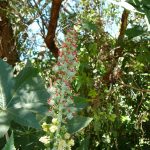Castor Oil Plant

Common name
Castor Oil Plant
Scientific Name
Ricinus communis
Type of plant
Tree And Shrub Weeds
About this weed
This large bush grows to 5 m tall and is often found in disturbed bushland and along rivers and creeklines. It has both male and female flowers (the male flowers are yellow and the female red) and according to Florabase ‘the seeds are very poisonous’. It was originally introduced as a garden plant and is native to tropical Africa, America and Asia.
Description
The Castor Oil Plant is a soft-wooded shrub or small tree to 5 m high. The leaves are on stalks and have seven to nine lobes. Flowers are produced in spring and the seeds are poisonous to humans and livestock. Fire triggers germination of the soil seed bank and disturbance triggers mass seed germination.
Impact on Bushland
If left will spread over bushland and impact on plant communities.
Location
It is scattered across wastelands, road verges, rail verges, rubbish tips, creeks and wetlands from Port Hedland to the Fraser Range.
Priority for removal
medium: can be a threat to the conservation values of Banksia woodlands and South-West Province.
Management (hand)
Hand pull seedlings and small plants, ensuring roots are removed.
Management (herbicide)
Cut and paint using 50% Glyphosate or apply 250 ml Access in 15 L of diesel to base 50 cm of trunk. Foliar spray seedlings and small plants using 1% Glyphosate. Read the manufacturers’ labels and material safety data sheets before using herbicides. Optimum treatment is from September to December.
Flowering month/s
January, February, March, November, December
Flower colour/s
Red, Yellow
Information source
https://florabase.dpaw.wa.gov.au/browse/profile/4705
Additional information
https://florabase.dpaw.wa.gov.au/weeds/swanweeds/
Hussey, B.M.J., Keighery, G.J., Dodd, J., Lloyd, S.G. and Cousens, R.D. (2007) Western weeds. A guide to the weeds of Western Australia, Second Edition, The Weeds Society of Western Australia, Victoria Park, Western Australia.




